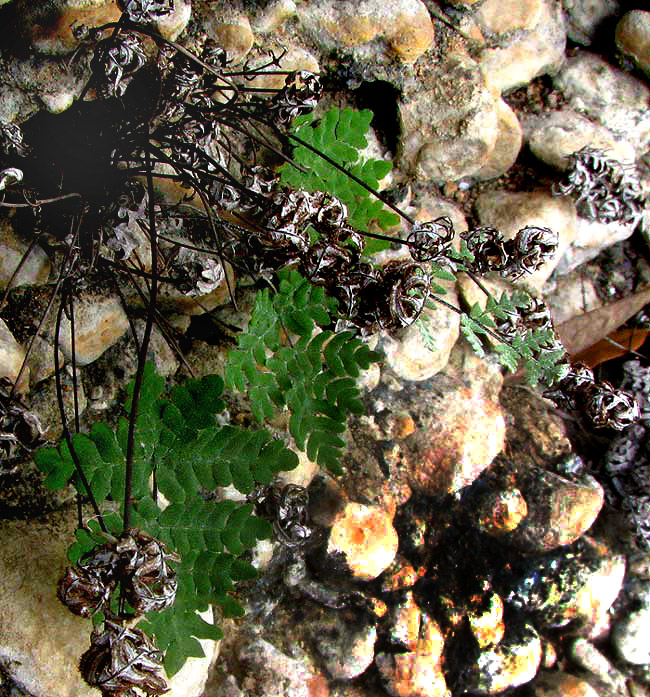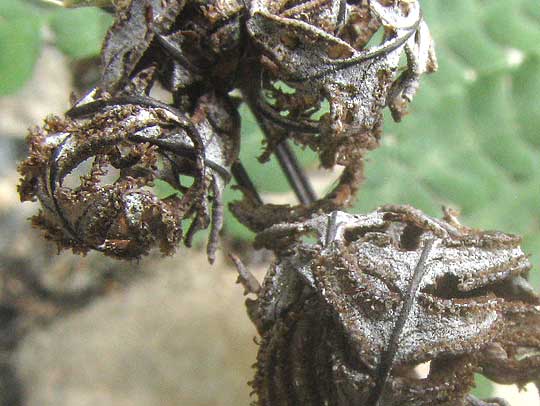Excerpts from Jim Conrad's
Naturalist Newsletter

from the September 29, 2013 Newsletter issued from the Frio Canyon Nature Education Center in the valley of the Dry Frio River in northern Uvalde County, southwestern Texas, on the southern border of the Edwards Plateau; elevation ~1750m (~5750 ft); N29.62°, W99.86°; USA
FALSE CLOAK FERN
Probably during a flashflood a few thousand years ago, a leg-deep stratum of rounded limestone pebbles was washed into an arroyo, in arid country an arroyo being a normally dry stream or gully. Over time the deposited layer dried out and the sandy, silty, calcium-carbonate-rich matrix between the pebbles cemented the mixture of pebbles, sand and silt into a massive formation of the composite rock type known as conglomerate.
Conglomerate is hard rock but nowadays a modern-day arroyo is eating away at the layer by undercutting it. Floodwater erodes softer rock from below the conglomerate, then big chunks of it fall into the streambed from their own weight. This results in a vertical, waist-high wall of conglomerate on one side of the arroyo. And in a crack in the solid face of this limestone-based conglomerate a fern grew I'd not seen before. It was unusually small, the fronds no longer than three inches (8cm), as shown at the top of this page, looking down on the fern emerging from the conglomerate wall.
Notice that some of the fronds are green, while others are shriveled into dry wads. Moreover, the shriveled ones have curled in such a way that the fronds' chalky-white undersurfaces face outwards, surrounding the green upper surfaces. The chalkiness is caused by a special kind of dense, short hairiness known as farina, the word farina usually being applied to flour, so the fronds' undersurfaces are "powdery white, like flour."
The green fronds are sterile, but the shriveled ones are fertile, producing spores. That's good because without the spores I'd be unable to identify the fern. A close-up of a shriveled fern wad displaying the spore arrangement on the frond's undersurface is shown below:

There you see that the sporangia -- the brown, granular little bags holding spores -- are lined up along the frond margins. Many ferns produce their sporangia scattered in distinctive groupings across the frond's undersurface. In rainier eastern North America the sporangium arrangement shown in the picture is mostly found among a handful of ferns specializing in dry cliff faces -- cliffbrakes and lip ferns. Here in southwestern Texas, so far about half the ferns species I've found are lip ferns, genus Cheilanthes, so I figured that this was yet another lip fern species, our fifth.
However, this little fern doesn't match any lip fern possibly found in our area. Fortunately, the fern section of the online Flora of North America is finished, so I could figure out what we had. It's a genus I'd never heard of. It's ARGYROCHOSMA DEALBATA, usually known as the Powdery False Cloak Fern or False Cloak Fern. "Real" cloak ferns are members of closely related genera, where this fern was relegated until the genus Argyrochosma came into existence in 1987.
Powdery False Cloak Ferns occur spottily on calcareous (limestone) cliffs and ledges mostly in the south-central US states -- Missouri and Kansas south to here in southwestern Texas.
What a pleasure to meet such an obscure, seldom encountered little fern that's so highly specialized for living on calcareous cliffs and ledges!